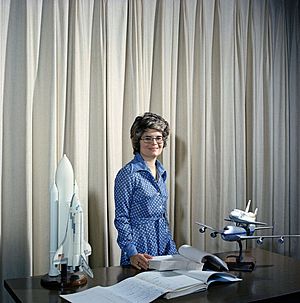Ivy Hooks facts for kids
Quick facts for kids
Ivy Hooks
|
|
|---|---|
 |
|
| Born | November 17, 1941 Houston, Texas, US
|
| Education | University of Houston (BS, MS) |
| Occupation | Engineer: National Aeronautics and Space Administration |
| Awards |
|
Ivy Fay Hooks (born November 17, 1941) is an amazing American mathematician and engineer. She worked for NASA, the famous space agency. Ivy joined NASA in 1965 after finishing her master's degree at the University of Houston.
Her first big job was on the Apollo program, which sent astronauts to the Moon. She helped figure out how light would look on the Moon's surface. She also studied how the launch escape system would work. Later, Ivy played a super important role in designing the Space Shuttle. She was one of only two women engineers on the original team that designed the orbiter.
Contents
Early Life and School Days
Ivy Fay Hooks was born in Houston, Texas, on November 17, 1941. She grew up in a town called Livingston, Texas. Her parents named her after Ivy Parker, a good friend and one of the people who started the Society of Women Engineers.
Ivy went to Livingston High School. After that, she started studying mathematics at Southwestern University in Georgetown, Texas. After her first year, she got married and moved to Lufkin, Texas. She then attended Austin College.
Later, Ivy transferred to the University of Houston for her third year of college. There, she also became very interested in physics. She earned her first degree, a Bachelor of Science in mathematics, in 1963.
Working at NASA
Joining the Space Team
In the early 1960s, it was not common for women to get jobs in mathematics. Ivy did not want to be a teacher, so she decided to go to graduate school. She worked towards her master's degree.
One day, a friend's mother showed her a newspaper article. It said, "NASA's looking for women scientists and engineers." Ivy went for an interview at the Manned Spaceflight Center. At first, she was not very impressed with the building. It was an old box factory with no windows.
However, she met a woman whose husband worked at NASA. He was looking for new people to join his team. Ivy had a second interview, and this job sounded much better to her. She was hired as an "aerospace technologist." This job title made some of the male engineers a bit annoyed because they had the same title.
Apollo Program Work
Ivy's first big project was to create models of how light would look on the Moon. This was super important because astronauts needed to know what they would see when they tried to land the lunar module. Most engineers were not very interested in this topic. It was not something they learned in college.
Ivy found that Russian scientists had studied this in the 1920s. They were interested in the Moon's albedo, which is how much light it reflects. They had already created detailed math for it.
At that time, very few women worked in technical roles at NASA. Sometimes, the men played mean jokes. Ivy got tired of two men in her group and decided to switch teams. She went to work for Humboldt C. Mandell, Jr. He was creating cost models, which were plans for future expenses. Ivy also went back to the University of Houston. She finished her studies and earned a Master of Science degree in mathematics in 1965.
Ivy also studied how the launch escape system worked. She looked at the effects of jet plumes from the Lunar Module's engines. She also investigated how the Apollo flight systems moved and behaved.
Designing the Space Shuttle
In April 1969, Ivy became one of only two women engineers on the first design team for the Space Shuttle Orbiter. She remembered that Max Faget walked into the room with a balsa wood model airplane. He said, "We're going to build America's next spacecraft. And it's going to launch like a spacecraft, it's going to land like a plane."
Ivy studied many different designs for this new spacecraft. She was especially involved in figuring out how the Space Shuttle Orbiter would separate from the Shuttle Carrier Aircraft. This was important for the Approach and Landing Tests.
Another big contribution Ivy made was figuring out how the Space Shuttle Solid Rocket Boosters would separate from the Space Shuttle external tank. For her amazing work on the Space Shuttle design, Ivy Hooks received two special awards. She got the Arthur S. Flemming Award in 1978. Then, in 1981, she received the NASA Exceptional Service Medal.
Software Leadership
Ivy saw that computers would become more and more important in the future. So, from 1973 to 1977, she led the Aerodynamics Systems Analysis Section. This group focused on how air moves around spacecraft.
From 1978 to 1980, she led the Spacecraft Software Division. She was also the Software Manager there from 1980 to 1981. From 1981 to 1982, she managed the Shuttle Data Office for the Space Shuttle Program. She continued to lead different software and operations teams until 1984.
Life After NASA
Ivy Hooks left NASA in 1984. She then joined Barrios Technology, a company that works with aerospace projects. In 1986, she became the President and CEO of Bruce G. Jackson and Associates. Later, she started her own software company called Compliance Automation.

